 Many years ago we passed through Northern Ireland as part of the Autoglass Round Britain Rally with the Shell Unleaded hopper. We had a quite a few adventures but never quite enough time anywhere for a look see. Keeping ahead of a bunch of rally drivers was task enough. We did briefly visit Belfast though and I have to say it wasn’t the prettiest place nor necessarily the most welcoming at the time but we did meet some very nice people despite them all thinking we were from the East End of London. Last year we were invited out to inspect a pile of balloons and my word, what a nice place we ended up in. The weather was spookily brilliant, massive cu-nims en-circled us but not once did it rain or the sun go in and we managed to get everything inspected and sorted in a day. The following morning I went on an instructor rating flight with Ray Noyce and Rowena Gooch whilst John disappeared with two mad Irishmen, Peter Hegarty and Peter Donnelly, a Flybe pilot, both intent on flying, or rather not flying, the balloon. We stayed in Draperstown, renowned for flights out of the wide High Street but once again the short stay scuppered any real chance to get an opportunity to get out and about. Next visit (if offered) would, we had decided, be a bit different.
Many years ago we passed through Northern Ireland as part of the Autoglass Round Britain Rally with the Shell Unleaded hopper. We had a quite a few adventures but never quite enough time anywhere for a look see. Keeping ahead of a bunch of rally drivers was task enough. We did briefly visit Belfast though and I have to say it wasn’t the prettiest place nor necessarily the most welcoming at the time but we did meet some very nice people despite them all thinking we were from the East End of London. Last year we were invited out to inspect a pile of balloons and my word, what a nice place we ended up in. The weather was spookily brilliant, massive cu-nims en-circled us but not once did it rain or the sun go in and we managed to get everything inspected and sorted in a day. The following morning I went on an instructor rating flight with Ray Noyce and Rowena Gooch whilst John disappeared with two mad Irishmen, Peter Hegarty and Peter Donnelly, a Flybe pilot, both intent on flying, or rather not flying, the balloon. We stayed in Draperstown, renowned for flights out of the wide High Street but once again the short stay scuppered any real chance to get an opportunity to get out and about. Next visit (if offered) would, we had decided, be a bit different.
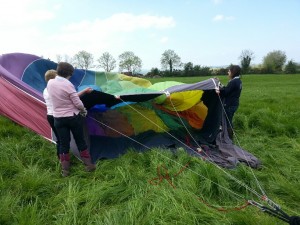 It didn’t take much persuading then when this year we were asked back so, with flights booked before you could wink, Stelios whisked us across the cloud-covered Irish Sea into Belfast International. I quite like Belfast Airport, it has a sort of innocence about it and is pleasantly relaxed. Equally relaxed was Simon Calvert who, as arranged, collected us from the front of the airport and in lovely warm sunshine whisked us away to his home in Doagh, County Down, and freshly baked scones and tea. True it was a bit on the blowy side with the forecast to pick so no flying today but everyone was soon gathered in his father-in-laws adjacent field and with trailers quickly emptied we got into some serious hardcore inspecting.
It didn’t take much persuading then when this year we were asked back so, with flights booked before you could wink, Stelios whisked us across the cloud-covered Irish Sea into Belfast International. I quite like Belfast Airport, it has a sort of innocence about it and is pleasantly relaxed. Equally relaxed was Simon Calvert who, as arranged, collected us from the front of the airport and in lovely warm sunshine whisked us away to his home in Doagh, County Down, and freshly baked scones and tea. True it was a bit on the blowy side with the forecast to pick so no flying today but everyone was soon gathered in his father-in-laws adjacent field and with trailers quickly emptied we got into some serious hardcore inspecting. 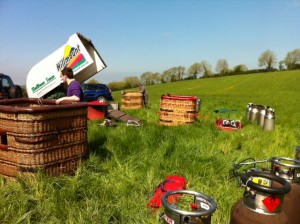 Amongst those that turned up were Sarah Villiers, Peter Hegarty who accommodated us the previous year in his fantastic hotel in Draperstown, the lovely Robin Mercer who had forgiven John for tearing his parachute last year, Sean McGuigan all smiles and a surprise visit from Bill McKinnon who just ‘happened by’. It was great, there were no disasters plenty of helpers and, apart from a couple of advisories, all were pronounced fit to fly. Late afternoon caught us up and equipment was rejoined with envelopes and all packed up in double quick time.
Amongst those that turned up were Sarah Villiers, Peter Hegarty who accommodated us the previous year in his fantastic hotel in Draperstown, the lovely Robin Mercer who had forgiven John for tearing his parachute last year, Sean McGuigan all smiles and a surprise visit from Bill McKinnon who just ‘happened by’. It was great, there were no disasters plenty of helpers and, apart from a couple of advisories, all were pronounced fit to fly. Late afternoon caught us up and equipment was rejoined with envelopes and all packed up in double quick time. 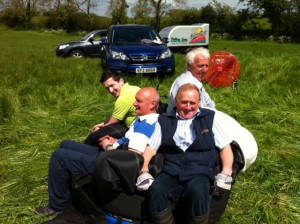 The weather once again had come up trumps, much to everyones’ relief. We had considered doing the deed in a day but, knowing how fickle Irish weather can be, to be on the safe side we’d gone out on the pyjama special and booked the late flight back the following day. With everything inspected we’d have a day to kill (after we’d done the paperwork of course) but it was time to adjourn to nearby Moira.
The weather once again had come up trumps, much to everyones’ relief. We had considered doing the deed in a day but, knowing how fickle Irish weather can be, to be on the safe side we’d gone out on the pyjama special and booked the late flight back the following day. With everything inspected we’d have a day to kill (after we’d done the paperwork of course) but it was time to adjourn to nearby Moira.
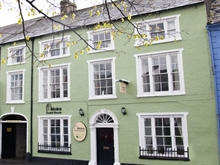 We dumped our carrier bags at our hotel for the night, The Moira Guest House, a beautiful Georgian Town House, and adjourned to Pretty Mary’s, a bar almost opposite and a meeting with Bill McKinnon to catch up with the latest gossip from India over a pint of the Black Stuff. In the entrance hall to this old pub was a very interesting wall of facts surrounding Moira which we studied intently. Apparently the first hothouse in Europe was built in Moira by Sir George Rawdon and it is reputed to have been the first village in which the famous Lambeg drums were made. These are the seriously big bass drums on steroids beaten with curved sticks and often seen in the Orange Order Marches, then in 1726 it is claimed the first Harvest Thanksgiving service in Ireland was held in Moira Church. It was also the site of the largest ever Irish funeral when 800 carriages of various kinds and 4000 people attended the funeral of the Earl of Moira in 1793 but clearly the most bizarre thing is that the first frogs in Ireland were discovered in Moira. Amazing.
We dumped our carrier bags at our hotel for the night, The Moira Guest House, a beautiful Georgian Town House, and adjourned to Pretty Mary’s, a bar almost opposite and a meeting with Bill McKinnon to catch up with the latest gossip from India over a pint of the Black Stuff. In the entrance hall to this old pub was a very interesting wall of facts surrounding Moira which we studied intently. Apparently the first hothouse in Europe was built in Moira by Sir George Rawdon and it is reputed to have been the first village in which the famous Lambeg drums were made. These are the seriously big bass drums on steroids beaten with curved sticks and often seen in the Orange Order Marches, then in 1726 it is claimed the first Harvest Thanksgiving service in Ireland was held in Moira Church. It was also the site of the largest ever Irish funeral when 800 carriages of various kinds and 4000 people attended the funeral of the Earl of Moira in 1793 but clearly the most bizarre thing is that the first frogs in Ireland were discovered in Moira. Amazing. 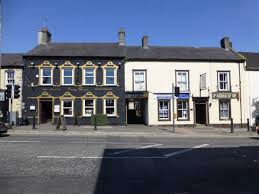 Pretty Mary’s comes from the name of an old fort now just earthworks a way up the road called, coincidently, Pretty Mary’s Fort. Quite who Pretty Mary was I have yet to discover but it’s a fine hostelry where we enjoyed an equally fine meal washed down with Guinness, obviously. When we finally got thrown out as a result of Simon’s kids misbehaving and making me bounce bits of sculpting clay about the establishment we bade then a fond goodnight and adjourned to the Three Trees, the name relating to three magnificent Rowan trees that once adorned the middle of the High Street and eventually where shaken to bits by the ever increasing traffic and had to be chopped down. This was a most eclectic place with a barman who had a great sense of humour and fine Guinness, as far as we can remember.
Pretty Mary’s comes from the name of an old fort now just earthworks a way up the road called, coincidently, Pretty Mary’s Fort. Quite who Pretty Mary was I have yet to discover but it’s a fine hostelry where we enjoyed an equally fine meal washed down with Guinness, obviously. When we finally got thrown out as a result of Simon’s kids misbehaving and making me bounce bits of sculpting clay about the establishment we bade then a fond goodnight and adjourned to the Three Trees, the name relating to three magnificent Rowan trees that once adorned the middle of the High Street and eventually where shaken to bits by the ever increasing traffic and had to be chopped down. This was a most eclectic place with a barman who had a great sense of humour and fine Guinness, as far as we can remember.
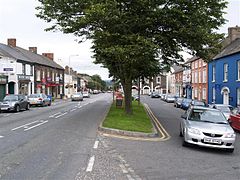 The morning dawned bright and breezy, very breezy and following a very nice breakfast we decided to have a wander up the street. Moira’s wealth, we discovered from a book in the lounge, derived from agriculture and the linen industry so when the rest of Ireland was having a hard time Moira was relatively wealthier. This is quite evident from the fantastic assortment of proper Georgian houses in the town. These are all the real thing and built in the 1700s not ‘faced’ examples of earlier houses more common in England. The Moira Guest House was one of the last individually owned town houses the rest now all having been converted into offices or flats. Most still feature the lovely fanlights above the front door and archway through to the rear. We decided it was a fine town with a fine butchers shop and bakery to boot. Our lift arrived at ten and off we went to wade through the paperwork helped by tea and more cakes. Job done Simon suggested that as we had a good half a day to kill before our flight left he could drop us off in Belfast, get some work done himself, then collect our bags and drop us off at the airport later. Brilliant idea.
The morning dawned bright and breezy, very breezy and following a very nice breakfast we decided to have a wander up the street. Moira’s wealth, we discovered from a book in the lounge, derived from agriculture and the linen industry so when the rest of Ireland was having a hard time Moira was relatively wealthier. This is quite evident from the fantastic assortment of proper Georgian houses in the town. These are all the real thing and built in the 1700s not ‘faced’ examples of earlier houses more common in England. The Moira Guest House was one of the last individually owned town houses the rest now all having been converted into offices or flats. Most still feature the lovely fanlights above the front door and archway through to the rear. We decided it was a fine town with a fine butchers shop and bakery to boot. Our lift arrived at ten and off we went to wade through the paperwork helped by tea and more cakes. Job done Simon suggested that as we had a good half a day to kill before our flight left he could drop us off in Belfast, get some work done himself, then collect our bags and drop us off at the airport later. Brilliant idea.
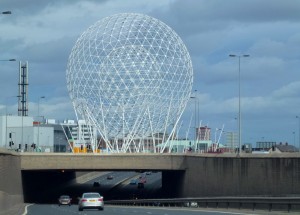 So it was that we found ourselves in the middle of Belfast having entered through areas previously remembered mostly with huge murals painted on the ends of terraced houses and barbed wire encrusted buildings. How things had changed. We came into the City via the Broadway Roundabout above which rises the very impressive Balls in the Falls sculpture or The Westicles, depending on who you ask. The place was fresh as a daisy and busy. As suggested we had a look round the Red Barn Gallery, a cleverly designed building with huge spaces and luvvie-type meeting place. There was a rather poignant photographic exhibition on featuring recent photographs showing some of the remains of the old buildings from the time of the Troubles. One series in particular featured the rubble and ruins of The Maze Prison as it was demolished. Very strange. “Its only a short walk to the Titanic exhibition from here”, said Simon as he’d driven off. Well now, in Ireland that phrase should be prefixed with ‘depending where you start from’. It wasn’t from the Red Barn Gallery.
So it was that we found ourselves in the middle of Belfast having entered through areas previously remembered mostly with huge murals painted on the ends of terraced houses and barbed wire encrusted buildings. How things had changed. We came into the City via the Broadway Roundabout above which rises the very impressive Balls in the Falls sculpture or The Westicles, depending on who you ask. The place was fresh as a daisy and busy. As suggested we had a look round the Red Barn Gallery, a cleverly designed building with huge spaces and luvvie-type meeting place. There was a rather poignant photographic exhibition on featuring recent photographs showing some of the remains of the old buildings from the time of the Troubles. One series in particular featured the rubble and ruins of The Maze Prison as it was demolished. Very strange. “Its only a short walk to the Titanic exhibition from here”, said Simon as he’d driven off. Well now, in Ireland that phrase should be prefixed with ‘depending where you start from’. It wasn’t from the Red Barn Gallery.  Spotting a large glass dome rising above the buildings we set off to investigate to discover a fantastic spiral staircase (in fairness there was a lift partway up) climbing into the huge glass-domed roof of the shopping mall. At the top was a small viewing platform inside the dome which afforded views right across the City. It was a spectacular piece of modernist architecture and accessible to all for nothing. From here we managed to spot the huge David and Goliath cranes of Harland and Wolff. Couldn’t be far from them and they were that-a-way…..
Spotting a large glass dome rising above the buildings we set off to investigate to discover a fantastic spiral staircase (in fairness there was a lift partway up) climbing into the huge glass-domed roof of the shopping mall. At the top was a small viewing platform inside the dome which afforded views right across the City. It was a spectacular piece of modernist architecture and accessible to all for nothing. From here we managed to spot the huge David and Goliath cranes of Harland and Wolff. Couldn’t be far from them and they were that-a-way…..
 I have always found it rather puzzling that a disaster the size of the Titanic has become almost something of a celebration. Bit like Bonfire Night where we celebrate Guy Fawkes failure to blow up the Houses of Parliament. Odd. Now if he’d succeeded! Think what you like, the success of the films of the disaster and now the regeneration of the area where it was built, rather unimaginatively called ‘The Titanic Quarter’, is keeping the story alive. Of course Titanic and her sister ships were built at Harland and Wolffe’s Belfast yard but many other renowned ships came down the enormous slipways there. To be fair to Belfast it has grasped the opportunity and is certainly making the most of the Titanic. Good luck to them. They have demolished a lot of the old shipyards’ buildings but the old H&W Drawing Offices remain and they have gone a built a rather remarkable, and certainly very impressive, ‘Titanic Experience’.
I have always found it rather puzzling that a disaster the size of the Titanic has become almost something of a celebration. Bit like Bonfire Night where we celebrate Guy Fawkes failure to blow up the Houses of Parliament. Odd. Now if he’d succeeded! Think what you like, the success of the films of the disaster and now the regeneration of the area where it was built, rather unimaginatively called ‘The Titanic Quarter’, is keeping the story alive. Of course Titanic and her sister ships were built at Harland and Wolffe’s Belfast yard but many other renowned ships came down the enormous slipways there. To be fair to Belfast it has grasped the opportunity and is certainly making the most of the Titanic. Good luck to them. They have demolished a lot of the old shipyards’ buildings but the old H&W Drawing Offices remain and they have gone a built a rather remarkable, and certainly very impressive, ‘Titanic Experience’. 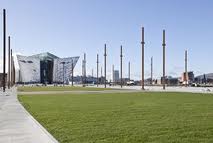 From a distance you don’t really get what the huge building is about but walk round the back onto the slipways and there it is, the bows of Titanic peeling back the sea in a headlong charge just like the old posters of the Ocean Liners. Interpreting the site when we visited was a little tricky as it was far from finished but it is well done and looks well-promising. Large poles mark out the lines of scaffold that surrounded the ships as they were assembled and the shape and rough plan of the deck and the ship’s outlines are depicted, the lines being lit at night.
From a distance you don’t really get what the huge building is about but walk round the back onto the slipways and there it is, the bows of Titanic peeling back the sea in a headlong charge just like the old posters of the Ocean Liners. Interpreting the site when we visited was a little tricky as it was far from finished but it is well done and looks well-promising. Large poles mark out the lines of scaffold that surrounded the ships as they were assembled and the shape and rough plan of the deck and the ship’s outlines are depicted, the lines being lit at night. 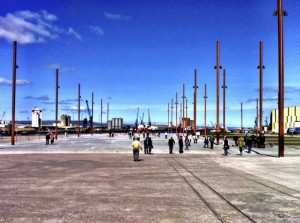 One outline has grassed over sections depicting the class of the survivors and those that lost their lives in the tragedy and a glass wall surrounding the huge front keel block lists all those that died. Despite the obvious tourist slant the place is pretty evocative and if you get your mind round the wealth that the site generated and how dependant it was for the local economy it really is quite special. The museum, or to be fairer Exhibition Building, is very bold both outside and in. We didn’t have time to go round and in any case you have to book a time which, we were told, was best to do on line. It was certainly heaving when we went and that was mid-week! What most forget, and we saw nothing to remind us, is that The Titanic was the middle of the three sister ships built on the slipways for The White Star Company.
One outline has grassed over sections depicting the class of the survivors and those that lost their lives in the tragedy and a glass wall surrounding the huge front keel block lists all those that died. Despite the obvious tourist slant the place is pretty evocative and if you get your mind round the wealth that the site generated and how dependant it was for the local economy it really is quite special. The museum, or to be fairer Exhibition Building, is very bold both outside and in. We didn’t have time to go round and in any case you have to book a time which, we were told, was best to do on line. It was certainly heaving when we went and that was mid-week! What most forget, and we saw nothing to remind us, is that The Titanic was the middle of the three sister ships built on the slipways for The White Star Company. 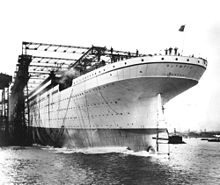 The first, RMS Olympic, was in service for 24 years serving as a troopship during the First World War and nick-named Old Reliable. Following the War she returned to trans-Atlantic passenger duties finally to be broken up in 1937. HMHS Britannic, the largest of the three ships, was completed after modifications following the loss of Titanic in 1914 entering service as a hospital ship in 1915. Following five successful voyages she struck a mine in the Kea Channel in the Meditterean and despite valiant attempts by the captain and crew to save her sunk with a loss of 30 from the 1066 on board. Harland and Wolff built all 88 of White Star Lines’ ships and, amongst many others, the cruiser HMS Belfast, now a museum ship in London and the Canberra.
The first, RMS Olympic, was in service for 24 years serving as a troopship during the First World War and nick-named Old Reliable. Following the War she returned to trans-Atlantic passenger duties finally to be broken up in 1937. HMHS Britannic, the largest of the three ships, was completed after modifications following the loss of Titanic in 1914 entering service as a hospital ship in 1915. Following five successful voyages she struck a mine in the Kea Channel in the Meditterean and despite valiant attempts by the captain and crew to save her sunk with a loss of 30 from the 1066 on board. Harland and Wolff built all 88 of White Star Lines’ ships and, amongst many others, the cruiser HMS Belfast, now a museum ship in London and the Canberra.  It would have been interesting to see how much of the rest of the areas rich nautical heritage is displayed in the Exhibition. By now the afternoon was drawing to a close so we headed shore-side for watering past the SS Nomandic, the last remaining White Star ship which sailed with Olympic on her maiden voyage becoming a tender carrying her, and later Titanic’s, passengers between ship and shore in the port of Cherborg. Although the sun shone the wind blew and gave this re-generated dockyard a feel of modern dereliction and it wasn’t even finished yet. We decided a return was needed in a few years time just to see.
It would have been interesting to see how much of the rest of the areas rich nautical heritage is displayed in the Exhibition. By now the afternoon was drawing to a close so we headed shore-side for watering past the SS Nomandic, the last remaining White Star ship which sailed with Olympic on her maiden voyage becoming a tender carrying her, and later Titanic’s, passengers between ship and shore in the port of Cherborg. Although the sun shone the wind blew and gave this re-generated dockyard a feel of modern dereliction and it wasn’t even finished yet. We decided a return was needed in a few years time just to see.
 If there is one place that we knew would be great no questions asked it was The Crown Bar. A must according to Mr Calvert. This seriously impressive place is perfection in Victoriana decadence. As it is now in the care of The National Trust and managed by Nicholson’s Pubs, part of Mitchells & Butlers, I told John we had to take advantage of my NT membership and enter immediately. Just across the road from the infamous Europa Hotel in Great Victoria Street, it is fabulous. Back in 1978 that good fellow John Betjeman managed to convince the National Trust to buy the place off of Bass and in 1981 nigh on half a million squid was spent restoring it, then in 2007, in conjunction with M&B, a further half a million got chucked at it to bring back to its original Victorian splendour. Although apparently built on the site of a much older pub this version dates from the 1840s and was originally called the Railway Tavern, explained the chap sitting at the end of the bar. Turned out he’d once been the manager! The original owner’s son, it seemed, had travelled the world and when he got back in 1885 set to decorating the place with a passion.
If there is one place that we knew would be great no questions asked it was The Crown Bar. A must according to Mr Calvert. This seriously impressive place is perfection in Victoriana decadence. As it is now in the care of The National Trust and managed by Nicholson’s Pubs, part of Mitchells & Butlers, I told John we had to take advantage of my NT membership and enter immediately. Just across the road from the infamous Europa Hotel in Great Victoria Street, it is fabulous. Back in 1978 that good fellow John Betjeman managed to convince the National Trust to buy the place off of Bass and in 1981 nigh on half a million squid was spent restoring it, then in 2007, in conjunction with M&B, a further half a million got chucked at it to bring back to its original Victorian splendour. Although apparently built on the site of a much older pub this version dates from the 1840s and was originally called the Railway Tavern, explained the chap sitting at the end of the bar. Turned out he’d once been the manager! The original owner’s son, it seemed, had travelled the world and when he got back in 1885 set to decorating the place with a passion.  There is so much variation in the extravagant decoration it is hard to take it all in and we didn’t even get a chance to check out the private wooden snugs resembling high sided private pews in Victorian churches complete with bell pulls to summon the barman and door which could be locked shut as they were all full! Stained glass, a ceramic bar topped with granite, bright tiling everywhere, decorated columns and still functioning gas lighting, which was being lit with aid of a long taper as we entered, made this eclectic place shimmer.
There is so much variation in the extravagant decoration it is hard to take it all in and we didn’t even get a chance to check out the private wooden snugs resembling high sided private pews in Victorian churches complete with bell pulls to summon the barman and door which could be locked shut as they were all full! Stained glass, a ceramic bar topped with granite, bright tiling everywhere, decorated columns and still functioning gas lighting, which was being lit with aid of a long taper as we entered, made this eclectic place shimmer.  Our new friend explained, with much merriment, that visiting Americans, and these days Japanese, walk in, take piccies and walk out. Bang on cue one such party wandered in, did the aforementioned and hurried out. Ten minutes later the Guide returned and spent a further ten minutes enquiring after an elderly, brightly dressed, jolly Japanese chap who spoke a very little English. Once recovered from a locked snug where he’d been clearly enjoying the Guinness he bade the gathered throng a traditional farewell and was escorted out to raucous cheers. The fine condition of the stained glassed and painted windows were another oft commented on feature and photos a-plenty taken of them but did we mention the Europa Hotel was opposite?
Our new friend explained, with much merriment, that visiting Americans, and these days Japanese, walk in, take piccies and walk out. Bang on cue one such party wandered in, did the aforementioned and hurried out. Ten minutes later the Guide returned and spent a further ten minutes enquiring after an elderly, brightly dressed, jolly Japanese chap who spoke a very little English. Once recovered from a locked snug where he’d been clearly enjoying the Guinness he bade the gathered throng a traditional farewell and was escorted out to raucous cheers. The fine condition of the stained glassed and painted windows were another oft commented on feature and photos a-plenty taken of them but did we mention the Europa Hotel was opposite? 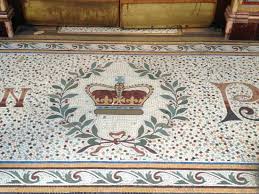 Well this hotel holds the unenviable claim to being the most bombed in Europe and as a result the windows are understandably far from truly original having been blown in on several occasions but they do look very authentic. We were sworn to secrecy concerning their true origin and age. This we sealed with our host by buying him (and us) another pint. Now the one thing that does miss most is the mosaic Crown that adorns the floor of the front porch. It was a private joke of course and reputedly the only place where you could officially trample the British Crown.
Well this hotel holds the unenviable claim to being the most bombed in Europe and as a result the windows are understandably far from truly original having been blown in on several occasions but they do look very authentic. We were sworn to secrecy concerning their true origin and age. This we sealed with our host by buying him (and us) another pint. Now the one thing that does miss most is the mosaic Crown that adorns the floor of the front porch. It was a private joke of course and reputedly the only place where you could officially trample the British Crown.
Eventually our splendid Trip Adviser turned up to retrieve us and as we carefully stepped round the Crown on the way out, reunited us with our respective bags of stuff and dropped us back at Sleepy Hollows Airport. The flight was half full and we were asked to use the more central seats, C&G and all that stuff, explained Nikita, the cabin manager as she was called. Drinks served, Stelios himself flew us gently across the Irish Sea and turned right.  From behind came a tap on John’s shoulder whereupon an elderly, brightly dressed, jolly Japanese chap popped his head round the seat. We looked at each other and grinned. Very politely he asked “ Ah, scoose me, you in Clown lerriler? Plane floor Sharon?” Laugh, John nearly spilt his G&T. At Luton we handed him over to the nice girl on the Easy Jet kiosk and she sent him to the nearby Isis Hotel booked on the first flight back in the morning. Thanks to all for yet another fine visit and your kind hospitality.
From behind came a tap on John’s shoulder whereupon an elderly, brightly dressed, jolly Japanese chap popped his head round the seat. We looked at each other and grinned. Very politely he asked “ Ah, scoose me, you in Clown lerriler? Plane floor Sharon?” Laugh, John nearly spilt his G&T. At Luton we handed him over to the nice girl on the Easy Jet kiosk and she sent him to the nearby Isis Hotel booked on the first flight back in the morning. Thanks to all for yet another fine visit and your kind hospitality.
And the porcelain fish? Well it is Ireland.
http://www.moiraguesthouse.com/
http://www.tripadvisor.co.uk/Hotel_Review-g445044-d1208354-Reviews-Apparo_Restaurant_Hotel-Draperstown_County_Londonderry_Northern_Ireland.html
http://www.apparorestaurant.co.uk/#home